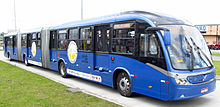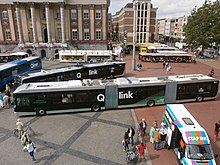Bi-articulated bus
This article needs additional citations for verification. (December 2009) |



A bi-articulated bus or double-articulated bus is a type of high-capacity articulated bus with an extra axle and a second articulation joint, as well as extended length. Bi-articulated buses tend to be employed in high-frequency core routes or bus rapid transit schemes rather than in conventional bus routes.
Design considerations
Common bi-articulated buses resemble rail vehicles in design. They often have elevated train-type doors instead of traditional bus doors to use dedicated stations. Payment is typically made at a bus station using a fare gate rather than on the bus.
Compared to using multiple smaller buses on a route, challenges using a bi-articulated bus include:
- difficulties maneuvering in traffic
- an increased turning radius
- the need to have extended length station platforms
- reduced frequency of service (one larger bus every 10 minutes rather than two regular sized buses coming once every 5 minutes)
- less flexibility for scheduling, routing, and maintenance.
However, an bi-articulated bus requires fewer drivers relative to the number of passengers per bus.
Early versions
In the late 1980s, the French manufacturers Renault and Heuliez Bus developed the "Mégabus" (officially the Heuliez GX237), a bi-articulated high-floor bus. The demonstrator Mégabus visited transit agencies throughout France, but the only city to order them was Bordeaux (an order of 10 buses, built in 1989). These buses, now retired, were used on Bordeaux's bus route 7[citation needed] until the city's tram system opened in 2004.[1]
Hungarian bus manufacturer Ikarus also developed a bi-articulated bus prototype, the Ikarus 293, in the early 1990s.[2]
In Bucharest, the ITB (today the STB) operated a double articulated trolleybus (unofficially called DAC 122E), made by adding a modified section between the first and the last sections of a DAC 117E articulated trolleybus, one of the sections coming from a damaged DAC 117E. This vehicle was built to fulfill the need of high capacity person transportation, which was proving difficult for the ITB in 1988, when the prototype was made. However, the DAC 117E's 125 kW traction motor proved insufficient for such a heavy vehicle, let alone the weight of passengers when it operated at full capacity. As a result, the vehicle was very slow and had trouble operating on grades, especially the incline between Cișmigiu Park and University Square. It also had trouble making sharp turns and was difficult to control, especially on snow or ice. This trolleybus was operated on long lines with wide roads and no major turns except the end of the lines like 69 and 90, but occasionally entered on lines 85, 66, 79 and 86. Bucharest traffic became increasingly intense in the very late 1990s, and RATB sought shorter trolleybuses. The DAC 122E was withdrawn from regular service, being occasionally used on lines 69 and 90 until 2000 when it was fully removed from service, displaced by the then-new Ikarus 415Ts and scrapped. Bucharest no longer operates bi-articulated vehicles (except for trams) due to high traffic levels, which is also the reason why between 2007 and 2018, the RATB refused to operate normal articulated buses.
Use



A bi-articulated bus is a long vehicle and usually requires a specially trained driver, as maneuvering (particularly reversing) can be difficult. Articulated electric trolleybuses can be difficult to control, with their motors producing momentary peak power in excess of 600 kilowatts (816 PS; 805 hp). The trailer section of a "puller" bus can be subject to unusual centripetal forces, which many people can find uncomfortable, although this is not an issue with "pushers". Bi-articulated buses are difficult to reverse park as joints force the bus into a zig-zag shape.
The transit system that has used bi-articulated buses the longest is the Rede Integrada de Transporte, in Curitiba, Brazil, which provides a type of service that has come to be known – particularly in American English – as bus rapid transit (BRT), where buses run in dedicated lanes and stop only at enclosed stations. Use of bi-articulated buses began in 1992,[3] with vehicles manufactured by Volvo (chassis) and Marcopolo/Ciferal (body), able to carry up to 270 passengers. Each bi-articulated bus is equipped with five doors where passengers can quickly load and unload. Buses stop only at enclosed, tube-shaped stations, where passengers pre-pay the fare and then board at the same level as the vehicle floor. Curitiba has over 170 bi-articulated buses in operation on routes serving five main corridors of dedicated bus lanes. These buses run on an average period of 50 seconds during peak hours.[citation needed]
Belgium
On 28 June 2020, the Flemish regional public tranport company De Lijn inaugurated the Ringtrambus (route 820) between Brussels Airport and Jette via Vilvoorde, operated half-hourly by 14 24-metre double-articulated buses. The service is presented as a step towards the tramline that was originally proposed.
Brazil
The Brazilian bus body manufacturers Marcopolo, CAIO, Busscar and most lately Neobus have made many bi-articulated buses on top of Volvo chassis. They are currently used in Rio de Janeiro, São Paulo, Campinas, Goiânia, Curitiba and, outside of Brazil, in Bogotá, Colombia.
In November 2016, Volvo launched the Volvo Gran Artic 300 bi-bus chassis, specifically developed in Brazil for BRT systems. At 30 metres (98 ft) long, this chassis is capable of carrying 300 passengers.[4][5][6]
Canada
In November 2019, Quebec City's Réseau de transport de la Capitale announced that it is planning to open the city's first BRT line along Boulevard Charest by 2026, utilizing a fleet of bi-articulated electric buses. Quebec City is the first and only North American city to make such an announcement.[7]
China
The Chinese manufacturer Youngman developed the JNP6250G bi-articulated bus for 300 passengers[8] with assistance from Neoplan. In 2007, these buses appeared on trial service in Beijing and were thought to be the world's longest, at 25 metres (82 ft) long.[9]
Colombia
TransMilenio in Bogotá has operated bi-articulated buses since 2009, having purchased 120 by 2013.[10][11] In 2020 it will receive a further 58.[12]
Czechia
The Belgian manufacturer Van Hool offers a 25-metre (82 ft) bi-articulated bus with a capacity of about 180 passengers. This bus is used in Prague, with line 119 connecting the Václav Havel Airport Prague with the rest of the city.[13]
Ecuador
Empresa de Pasajeros de Quito in Quito operates bi-articulated buses since 2016, having purchased 80.[14] They are Volvo DH12D buses, model B340M EURO 3, with a diesel tank capacity of 120 gallons and a power of 340 HP. The chassis is a bi-articulated Volvo B340M. [15]
Germany
The Belgian manufacturer Van Hool offers a 25-metre (82 ft) bi-articulated bus with a capacity of about 180 passengers. These buses are used in the German cities of Aachen (lines 5 and 45) and Hamburg (Metrobus 5 and Eilbus E86), where single-articulated buses alone were not able to handle the huge number of passengers per day. In Hamburg they were retired in 2018 after 13 years of service as they started to require more and more maintenance due to their growing age and an unusual level of wear and tear, caused by the second articulation joint.[16]
In 2012, Fraunhofer IVI introduced the AutoTram Extra Grand in Dresden.[17] With overall length of 30.73 metres (100 ft 10 in) it is the longest bus in service with a passenger capacity of 256. Its unique 5-axle design is made possible using advanced computer controlled steering on the 3 trailing axles.
Luxembourg
The Swiss manufacturer Hess produces a bi-articulated, hybrid-engine bus based on the LighTram. This type is currently in use for the Luxembourgian bus operator Voyages Emile Weber.[18]
Netherlands
The Belgian manufacturer Van Hool offers a 25-metre (82 ft) bi-articulated bus with a capacity of about 180 passengers. In September 2002, fifteen were deployed on lines 11 and 12 in Utrecht, connecting the central railway station to office, college and university buildings at the edge of the city.[19] Twelve more have been added since.
From August 2014 to 2016, Swiss manufacturer Hess's bi-articulated LighTram buses were in service in Groningen, Netherlands on the route from the main train station via the city centre to the university north of the city. In 2016 these buses were moved to Utrecht because the few stops and higher speeds on this line made the hybrid engine perform poorly.
Sweden
Volvo has manufactured several bi-articulated buses now in use in Gothenburg. They are based on Volvo's "puller"-type articulated, low-floor bus model with the internal combustion engine mounted on the floor on the side of the bus, and the cooling system on the roof. They have not manufactured anymore and are currently being replaced by normal articulated buses.
Switzerland
The Swiss manufacturer Hess produces a bi-articulated trolleybus called LighTram that is in use in several Swiss cities, including Zürich, Geneva and Lucerne.
See also
References
- ^ "French buses - the Megabus and other PR100 oddities". Archived from the original on December 5, 2007.
- ^ "Autobusové noviny :: IKARUS 293". Archived from the original on 2011-07-18. Retrieved 2010-11-12.
- ^ Bushell, Chris (ed.) (1993). Jane's Urban Transport Systems 1993-94, pp. 79–80. Coulsdon, Surrey (UK): Jane's Information Group. ISBN 0-7106-1072-6.
- ^ Volvo launches the world's largest bus Volvo Buses November 24, 2016
- ^ Volvo will sell the world's largest bus in Brazil Auto Blog November 29, 2016
- ^ The world's longest bus Australasian Bus & Coach December 2, 2016
- ^ "Réseau". reseaustructurant.info (in French). Retrieved 2020-01-10.
- ^ http://inhabitat.com/worlds-largest-bus-chinas-300-passenger-youngman-jnp6250g-set-to-serve-beijing-and-hangzhou/
- ^ an article in Shanghai Daily - 'World's largest' bus debuts in Shanghai By Kat Jiang 2007-3-14
- ^ First Set of Transmilenio Bi-articulated Buses Launched in Bogotá Institution for Transport & Development Policy August 19, 2009
- ^ Volvo Sells 120 Bi-articulated chassis for Bogotá BRT system Volvo August 27, 2012
- ^ Transdev in Colombia extends & expands TransMilenio fleet Archived 2018-05-28 at the Wayback Machine Transdev March 21, 2018
- ^ Endrštová, Michaela (2016-11-14). "Na letiště začal jezdit nejdelší autobus v Česku. Je to zážitek, říká řidič". iDnes (in Czech). MAFRA a.s. Retrieved 23 June 2018.
- ^ [[1]]
- ^ [[2]]
- ^ "Tschüs, Langer! Heute rollt der letzte XXL-Bus durch Hamburg" (in German). Hamburger Morgenpost. 14 September 2018. Retrieved 2018-09-15.
- ^ http://www.autotram.info/en.html
- ^ "News archive for Luxembourg" (in German). stadtbus.de. Retrieved 2010-09-27.
- ^ "Geschiedenis in vogelvlucht" (in Dutch). Het GVU - Openbaar Vervoer in Utrecht en omgeving. Archived from the original on 2007-02-06. Retrieved 2007-01-07.

